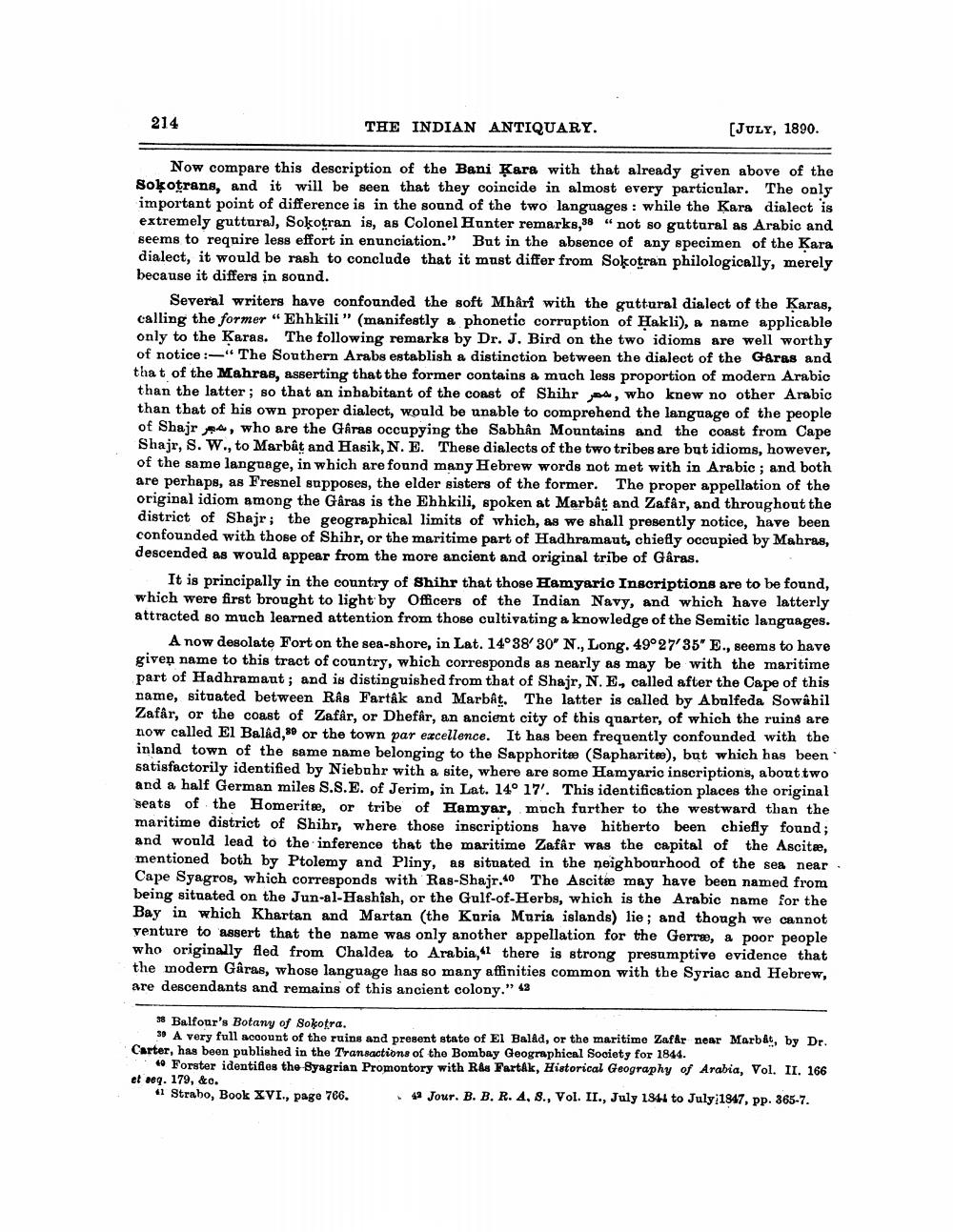________________
214
THE INDIAN ANTIQUARY.
[JULY, 1890.
Now compare this description of the Bani Kara with that already given above of the Sokotrans, and it will be seen that they coincide in almost every particular. The only important point of difference is in the sound of the two languages: while the Kara dialect is extremely guttural, Sokotran is, as Colonel Hunter remarks,38 "not so guttural as Arabic and seems to require less effort in enunciation." But in the absence of any specimen of the Kara dialect, it would be rash to conclude that it must differ from Sokotran philologically, merely because it differs in sound.
Several writers have confounded the soft Mhârî with the guttural dialect of the Karas, calling the former "Ehhkili" (manifestly a phonetic corruption of Hakli), a name applicable only to the Karas. The following remarks by Dr. J. Bird on the two idioms are well worthy of notice: The Southern Arabs establish a distinction between the dialect of the Garas and that of the Mahras, asserting that the former contains a much less proportion of modern Arabic than the latter; so that an inhabitant of the coast of Shihr, who knew no other Arabic than that of his own proper dialect, would be unable to comprehend the language of the people of Shajr, who are the Gâras occupying the Sabhân Mountains and the coast from Cape Shajr, S. W., to Marbât and Hasik, N. E. These dialects of the two tribes are but idioms, however, of the same language, in which are found many Hebrew words not met with in Arabic; and both are perhaps, as Fresnel supposes, the elder sisters of the former. The proper appellation of the original idiom among the Gâras is the Ehhkili, spoken at Marbât and Zafar, and throughout the district of Shajr; the geographical limits of which, as we shall presently notice, have been confounded with those of Shihr, or the maritime part of Hadhramaut, chiefly occupied by Mahras, descended as would appear from the more ancient and original tribe of Gâras.
It is principally in the country of Shihr that those Hamyaric Inscriptions are to be found, which were first brought to light by Officers of the Indian Navy, and which have latterly attracted so much learned attention from those cultivating a knowledge of the Semitic languages.
A now desolate Fort on the sea-shore, in Lat. 14°38' 30" N., Long. 49°27′35′′ E., seems to have given name to this tract of country, which corresponds as nearly as may be with the maritime part of Hadhramaut; and is distinguished from that of Shajr, N. E, called after the Cape of this name, situated between Râs Fartâk and Marbât. The latter is called by Abulfeda Sowâhil Zafar, or the coast of Zafâr, or Dhefâr, an ancient city of this quarter, of which the ruins are now called El Balâd,80 or the town par excellence. It has been frequently confounded with the inland town of the same name belonging to the Sapphorite (Sapharitee), but which has been satisfactorily identified by Niebuhr with a site, where are some Hamyaric inscriptions, about two and a half German miles S.S.E. of Jerim, in Lat. 14° 17'. This identification places the original seats of the Homeritse, or tribe of Hamyar, much further to the westward than the maritime district of Shihr, where those inscriptions have hitherto been chiefly found; and would lead to the inference that the maritime Zafâr was the capital of the Ascitæ, mentioned both by Ptolemy and Pliny, as situated in the neighbourhood of the sea near Cape Syagros, which corresponds with Ras-Shajr.40 The Ascite may have been named from being situated on the Jun-al-Hashish, or the Gulf-of-Herbs, which is the Arabic name for the Bay in which Khartan and Martan (the Kuria Muria islands) lie; and though we cannot venture to assert that the name was only another appellation for the Gerræ, a poor people who originally fled from Chaldea to Arabia, there is strong presumptive evidence that the modern Gâras, whose language has so many affinities common with the Syriac and Hebrew, are descendants and remains of this ancient colony." 43
38 Balfour's Botany of Sokotra.
39 A very full account of the ruins and present state of El Balâd, or the maritime Zafår near Marbat, by Dr. Carter, has been published in the Transactions of the Bombay Geographical Society for 1844.
40 Forster identifies the Syagrian Promontory with Ras Fartak, Historical Geography of Arabia, Vol. II. 166 et seq. 179, &c.
41 Strabo, Book XVI., page 766.
42 Jour. B. B. R. A, 8., Vol. II., July 1844 to July 1947, pp. 365-7.




